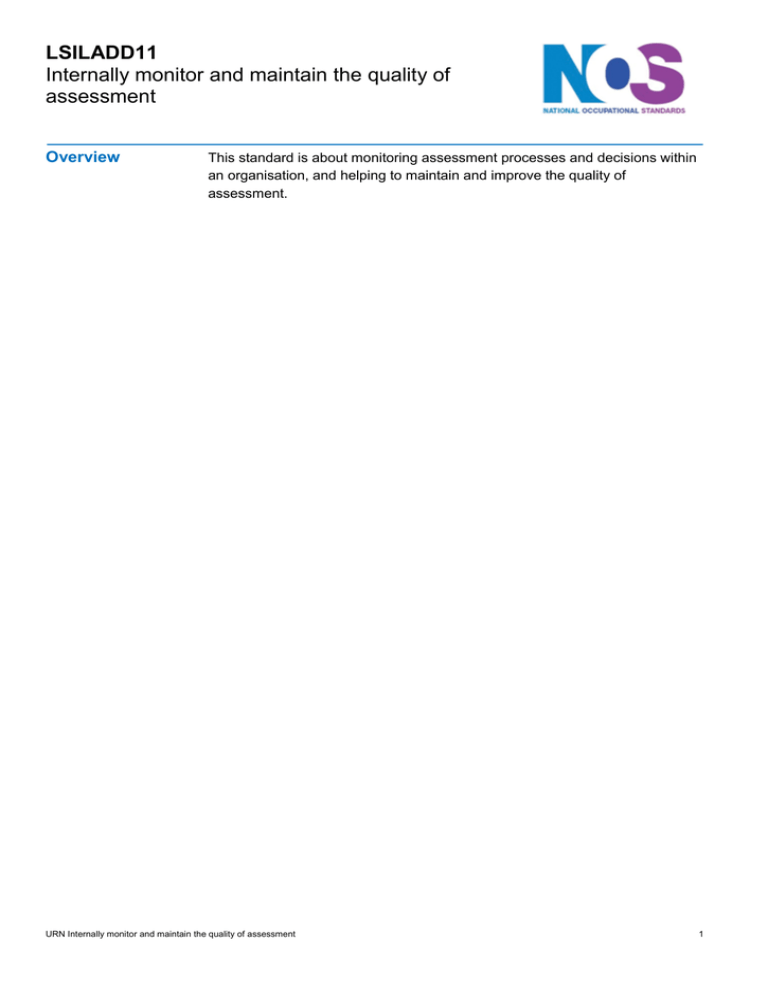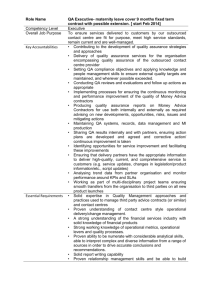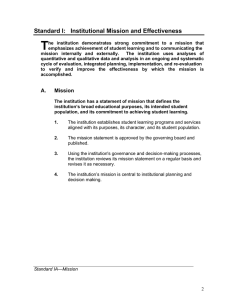Internally monitor and maintain the quality of assessment
advertisement

LSILADD11 Internally monitor and maintain the quality of assessment Overview This standard is about monitoring assessment processes and decisions within an organisation, and helping to maintain and improve the quality of assessment. URN Internally monitor and maintain the quality of assessment 1 LSILADD11 Internally monitor and maintain the quality of assessment Performance criteria You must be able to: P1 P2 P3 P4 P5 P6 P7 P8 P9 P10 P11 plan and prepare monitoring activities according to the requirements of own role determine whether assessment processes and systems meet and operate according to quality requirements check that assessors meet the requirements for their role check that assessments are planned, prepared for and carried out according to agreed procedures check that assessment methods are safe, fair, valid and reliable check that assessment decisions are made using specified criteria compare assessor decisions to ensure they are consistent provide assessors with feedback, advice and support to help them maintain and improve their assessment practice work with others to ensure the standardisation of assessment practice and outcomes follow agreed procedures when there are significant concerns about the quality of assessment follow agreed procedures for the recording, storing, reporting and confidentiality of information URN Internally monitor and maintain the quality of assessment 2 LSILADD11 Internally monitor and maintain the quality of assessment Knowledge and understanding You need to know and understand: K1 K2 K3 K4 K5 K6 K7 K8 K9 K10 K11 K12 K13 K14 K15 K16 K17 K18 the current quality requirements for assessment processes and systems in their area of responsibility the key concepts and principles of quality assurance the key concepts and principles of assessment the role of the assessor and the relevant requirements of the role the roles of those involved in maintaining the quality of assessment and the relevant requirements of these roles the agreed procedures for planning, preparing for and carrying out assessments techniques for sampling evidence of assessment, including making appropriate use of technology appropriate criteria for judging the quality of the assessment process how to ensure the health and safety of the learner is maintained during assessment the uses, benefits and drawbacks of different assessment methods the types of feedback, support and advice that assessors need and how to meet these needs issues related to equality, diversity and if relevant, bilingualism, that may affect assessment and quality assurance, and how to address these procedures to follow when there are concerns about the quality of assessment: when and how to use them standardisation processes and how to co-ordinate and contribute to these the procedures to follow when there are disputes concerning assessment and quality assurance procedures to follow when planning and preparing for, carrying out and recording monitoring activity the requirements for information management, data protection and confidentiality in relation to assessment and quality assurance the value and purpose of continuing professional development for assessment and quality assurance practitioners URN Internally monitor and maintain the quality of assessment 3 LSILADD11 Internally monitor and maintain the quality of assessment Additional Information Please visit the website link to access the NOS suite including the Introduction, which contains valuable context and background information for this suite of NOS. http://webarchive.nationalarchives.gov.uk/20110414152025/http://www.lluk.org/standardsand-qualifications/standards/learning-and-development-national-occupational-standards/ Glossary Assessment method For example, observation, questioning, checking products of work, setting assignments Candidate The learner being assessed Equality A state of fair treatment that is the right of all people regardless of differences in culture, ability, gender race, religion, wealth, sexual orientation, or any other group characteristic Diversity Acknowledging that each individual is unique, and recognizing our individual differences in culture, ability, gender, race, religion, wealth, sexual orientation, or any other individual characteristic Organisation For example, an awarding organisation, internal department or any other organisation involved in assessment Reliable Consistently achieves the same results with the same (or similar) group of learners Requirements for their role This could include holding an assessor qualification and/or being expert in the subject being assessed Sufficient Enough evidence as specified in Evidence Requirements or Assessment Strategy Valid Relevant to the criteria against which the candidate is being assessed URN Internally monitor and maintain the quality of assessment 4 LSILADD11 Internally monitor and maintain the quality of assessment Developed by Learning and Skills Improvement Service Version number 1 Date approved March 2010 Indicative review date March 2012 Validity Current Status Original Originating organisation Lifelong Learning UK Original URN LaD11 Relevant occupations Education and training; Teaching and lecturing; Direct learning support; Teaching Professionals; Public Service Professionals Suite Learning and Development (2010) Key words assessment decisions, assessment processes, assessment systems, feedback to assessors, improve quality assurance, internal quality assurers, internal verifiers, internally verify, learning development practitioners, maintain quality assurance, monitor assurance URN Internally monitor and maintain the quality of assessment 5



